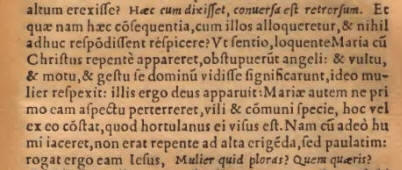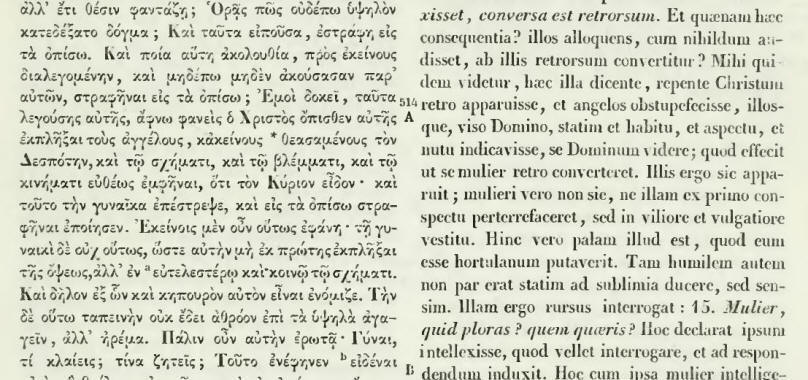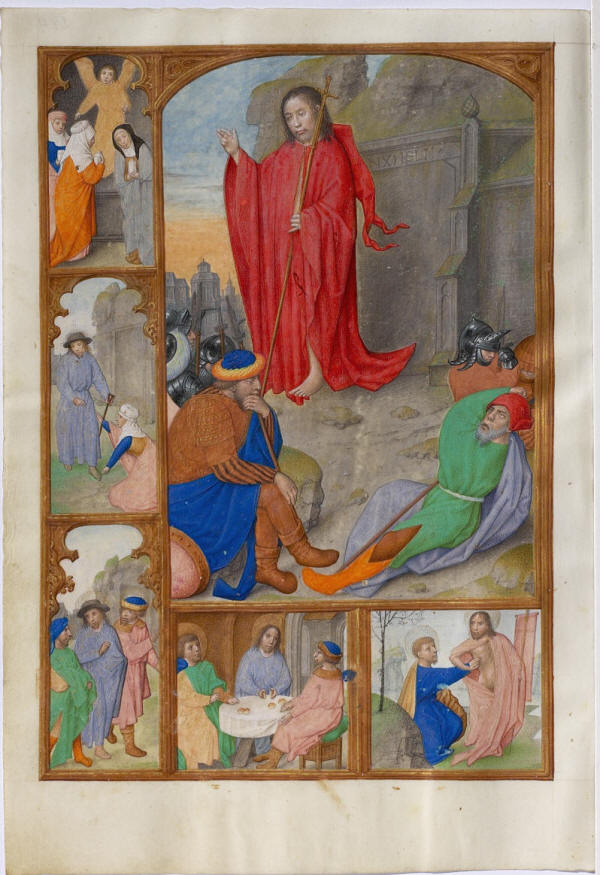And Mary turned around and saw... a
gardener
Some relevant quotes from patristic
sources referring to Jesus as a gardener and the spiritual correctness of
Mary's error. In a spiritual sense Jesus is a gardenere. He sows the
seeds of faith in Mary's heart (Augustine, Gregory the Great). Broader it refers
to the tradition of the hortus conclusus
(linking this garden with Eden, the tree of life, Gethsemane and the Song of
Songs (f.i. Cyril of Jerusalem). Stunning: Mary's mistake is not
necessarily a visual error (esp. in Chrysostom's sermon), but caused by Jesus
himself who really looked like a gardener (dress and equipment). I found these
quotes in a wonderful book: Anthony M. Moore, 2013, Signs of Salvation, The
Theme of Creation in the Fourth Gospel. pp 86-93.
In recent research a same realism
is found in medieval Easter-plays (perhaps connected to the increase in
pictures of Noli me tangere)
where Jesus appears to Mary Magdalene as a true gardener, not in angelic way
(Fra Angelico), but dressed like one, with shovel, hoe, hat (see image = Rembrandt).
Jesus played a 'trick' on Mary. For this, R. Warning, Seeing and
Hearing in Ancient and Medieval Epiphany and De Boer/Göttler, Religion
and the Senses in Early Modern Europe (in particular the essay by B. Baert)
Augustine:
In Tractate CXXI
(homily on Jn 20:10-19) Augustine first defends Mary for mistaking Jesus for the
gardener (or vice versa) and then, after the noli me tangere scene,
Augustine returns to the image of Jesus as the hortulanus depicting him
as sowing the grain of mustard seed in Mary Magdalene's heart:
There are
points in these words which we must examine with brevity indeed, but with
somewhat more than ordinary attention. For Jesus was giving a lesson in
faith to the woman, who had recognized Him as her Master, and called Him so
in her reply; and this gardener was sowing in her heart, as in His own
garden, the grain of mustard seed.
Est in his verbis quod breviter quidem, sed tamen attentius pertractare
debemus. Jesus quippe mulierem quae illum magistrum agnovitet
appellavit, cum haec ei responderet, fidem docebat: et hortulanus ille
in ejus corde, tamquam in horto suo granum sinapis seminabat.
(Opera Omnia, ed. Maurist Benedictines (Paris:
Gaume Brothers, 1837), Vol. 3. English translation john Gibb in in
Philip Schaff (ed.), St Augustine: Homilies on the Gospel of John...(Nicene
and Post-Nicene Fathers, First Series, Edinburgh: T&T Clark, 1888,
Vol. 7, 437.
//newadvent.org/fathers/1701121.htm
John
Chrysostom (sermon 87):
When she
[Mary Magdalene] had said this, she turned around' (Jn 20:14): And by
what kind of consequence is it, that she having spoken to them, and not
having yet heard anything from them, turned back? Methinks that while she
was speaking, Christ suddenly appearing behind her, struck the Angels with
awe; and that they having beheld their Ruler [despotès], showed
immediately by their bearing, their look, their movements that they saw the
Lord; and this drew the woman's attention, and caused her to turn herself
backwards. To them then He appeared on this wise, but not so to the woman,
in order not at the first sight to terrify her, but in a more common and ordinary
form, as is clear from her supposing that He was the gardener [kèpouros].
It was meet to lead one of so lowly a mind to high matters, not all at once,
but gently.
In honour of our Greek Patres, the original (as image,
otherwise....). I highlighted the phrase with hortulanus (kèpouros
in Greek) :

English translation: Charles Marriott in Philip
Schaff (ed.), St Chrysostom (Nicene and Post-Nicene Fathers,
First Series, Edinburgh: T&T Clark, 1888, Vol. 14, 323
//newadvent.org/fathers/240186.htm
|

|
Two Latin translations. Above a translation made by Fr. Aretion
dedicated to Cosimo de Medici (ca. 1459) from a Paris edition 1543.
Below the textedition with Latin translation Opera Omnia quae
existant, vol. 9, procured by Bernard de Montfaucon (Mauri). The
Greek word is 'kèpouros', the Latin 'hortulanus'.
|
|

Gregory the Great (Homiliarum in Evangelia
LXXVI, Migne Patrologiae Cursus Completus, 1191) sees deeper significance in the
Magdalene's 'misunderstanding' of Jesus to be the gardener and, in theological
terms, comes close to sharing Augustine's interpretation
Perhaps this
woman erred by not erring, who thought Jesus was the gardener. For was he
not to her a spiritual gardener [hortulanus], who in her breast used
to plant sprouting seeds of virtues through his love ?
Forsitan nec errando haec mulier erravit, quae Jesum hortulanum
credidit. An non ei spiritaliter hortulanus erat, qui in ejus pectore
per amoris sui semina virtutum virentia plantabat?
English: Rev'd Dr. Hugh Houghton (University of
Birmingham)
Broader: merging
the garden (of Eden - Paradise), the garden of the Song of Songs (where the
bride meets the groom), and the garden of Gethsemane (with tree, where Jesus
dies) and the garden of the resurrection is not at all unusual in patristic
exegesis. Moore shows this in Cyril of Jerusalem (Catechetical lecture XIII,
on the Words, Crucified and Buried) and Clemens of Alexandria. They also
alternate the greek word for 'garden' (kèpos) and 'paradise'. A cross-over of
meaning.
Finally: a page
from the Breviary in the Museum Mayer van den Bergh (Antwerp) with the
Easter-scenes according tot the gospel of John, with the Hortulanus.

|
|
|
|




